Eating the last pumpkin of 2010
So you have water in the coop- fantastic! This may be a good time to invest in some heater tape. If have an air leak near your intake or a cold area under your coop/barn, and even if you insulate, you might also need some heater tape. This is available at all hardware and some feed/ag stores, and even in unheated spaces like our barn, it prevents ice crystals in the pipe which can cause intermittent freezing and thawing.
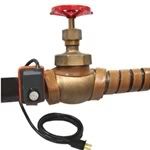
Now our barn is quite rough, but here is the uptake from underground, houses in a box that is insulated. There is an electric outlet in the box and the tape is plugged into it. Even if we have extreme low temps to -20C with wind, this device protects the water. We have even had it hold out after prolonged power outages of 2-3 days.
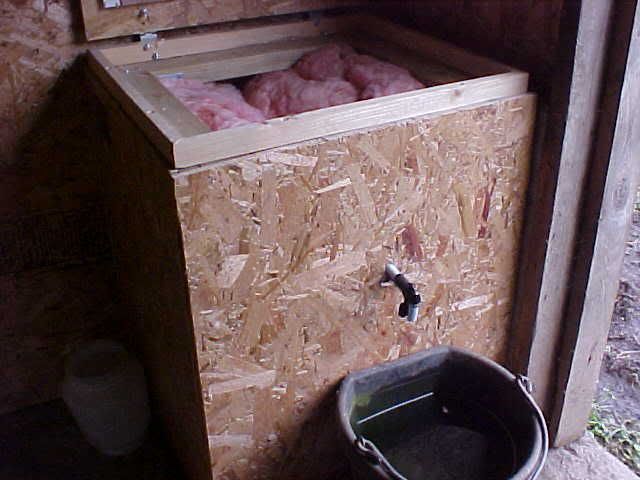
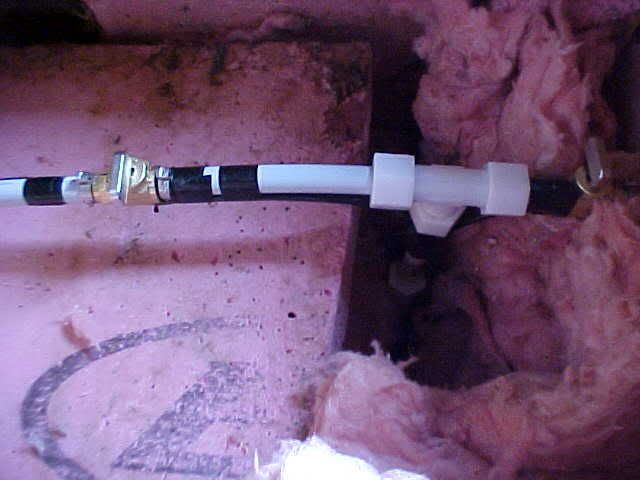
I have to confess that some of the modifications we made to the coop and run are for my comfort. And speaking of that, there is nothing quite so comforting as a strong roof on part or all of your run. If the coop is small, even a porch outside the pop door does wonders because chickens that don't want to be out can enjoy some light without much wind. If you have some scrap plexiglass, vinyl or vapour barrier you can provide both light and protection. It doesn't take a lot and is worth having the birds in a snow and wind-free zone. If you get a heavy snow, this protection extends to the hardware on your pop door and ensures that you can get out there, do your chores and get back to the warm house asap. Just be sure that the roof can hold a snow load, or is sloped sufficiently to shed the mass safely.
If you get into a situation where the temps are abysmal, lightly bury a few apples or some squash in the hen's bedding. Even if the waterer gives up and especially if you lose power to an electric waterer, the moisture keeps the birds going while you cope. Remember to score the squash, or pumpkin so the flesh is accessible.
Use sheets of vinyl, vapour barrier or used plastic to baffle the wind. If you can manage to frame it, you can remove in summer and put it back up the following year. Snow boards are good too, they cut the wind and when the snow builds it acts as an insulator. We used old sheathing that had been in horse stalls.
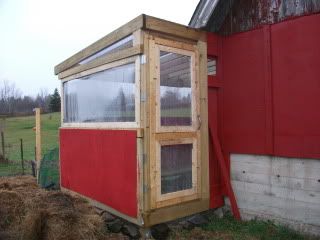
If you have a convenient electric outlet, perhaps one by your back door, you can use an electric dog bowl for the chooks and other pets:
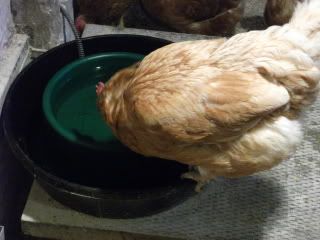
I use a rubber stock bowl under mine so that the hens perch on the outer edge and keep the water cleaner. Sheltered is better of course if you have a porch or can set something over it.
Make a huddle box. Old crate is ideal, place it upside down and load it with bedding. Try to find one the right size that your hens can fill it without piling-on. If you cut two openings, that's even better, but leave two sides baffled to any drafts.
It's bad enough that you have had dreadfully cold weather, but after you can have thaw problems. One of these is mould. If you see any, you need to change bedding if you have enough, and check nest boxes and all other parts of the coop in case melting snow is creeping in. The spores of most moulds are harmful to birds and can cause severe respiratory illness.
It also helps to dessicate the mould with food-grade diatom powder or one of the various stall products especially those made for horses. Ventilate well as you are able and re-check that the wood or other substrate is not fostering the mould even after you clean the first bit. Think dry, dry dry.
Ice and snow can creep up under the edge of shingles and you may not have needed 'drip edging' before to direct water off the edge of the roof of your coop (or home), it's inexpensive and stops the building under your shingles. It can be installed on any day at 10C or above. You may have some drips causing mould if you have not been using this.There is another aspect to winter chickenry that deserves notice. Not only must we contend with cold and frozen water, but also with moulting at the very time that the days begin to shorten. Because the birds have been without as much light, they can be deficient in Vitamin D at this time and beyond the winter solstice. It can delay moult and interfere with egg quality when hens begin laying again.
You may be offering plenty of limestone and it may also be in the layer feed, but without Vitamin D the 'medullary complex' of the hen ( the pelvis and other bones involved in shifting calcium around) may not have all they need to make the shells. Calcium and Vitamin D in sufficient quantities are vital. A hen can become very stressed without enough of both as winter deepens.
Easiest solution is to give poultry vitamins in the water or infant liquid vitamins, the kind without added iron ( hard on the kidneys). Or you can offer cod liver oil. Put some in the bottom of the font every day until you notice the hen pick up and produce. Then do so every few days. A sure sign of this can be a limp not caused by trauma.
My old hens are on multivitamins in water now every day and I'm starting to get eggs.
On the same note, if you had a large bag of layer feed at the start of winter, its nutritional value may be declining. Same solution!
It's January 23, 2011 and we are in a period of severe low temperatures and they are expected to worsen for several days until a snow storm comes up the I-95 from the Carolinas. I was able to open the pop door today because it is calm. When I can, I want the ladies to have a choice, knowing that in coming days they may be indoors and cranky at that decision. I have a large spaghetti squash saved to tomorrow, when record low temps are expected.
The past three days have been a serious challenge. For over 48 hours we experienced chill factors of -31 C. This is where the coop design paid off. I kept the hens in, and they had sufficient floor and platform space to avoid conflict. They enjoyed a huge spaghetti squash I had been saving for them and the insulated coop did not go below -4C despite high winds. It was the kind of weather that makes you wonder if it's safe to take another breath. The electric water bowl worked beautifully, even though the catch bucket iced up the moment I removed it from the coop.
In the main part of the bran the cats continued to have plenty of drinking water and I vitaminized theirs and that of the hens. Keeping vitamin D3 levels up during the dark heart of winter is important for all mammals and birds, especially when they must be indoors. No frostbite. But I was bundled up so tight I could barely move. I brought a hot thermos of water to the barn to unplug the tip of the tap on our water source; the inside was toasty with the heater tape but I find that a plug of ice forms just at the end of the tap during severe cold. We may get more of this in February, and we're expecting a snow storm overnight, January 26, 2011.
The storms continue, averaging one every 5 days. This one, a 'double whammy, on Feb. 01 and 02, 2011, is expected to affect 100 million in North America. It was -15C before chill factor before I went to tend the hens, and a broadcaster on CTV eas urging folks to exercise even in the brutal cold, because 'experts' advise it. But after donning panties, bra, thermal vest, thermal T, thermal crew, leggings, pants, acrylic socks, wool socks, Baffin boots, scarf, anorak, touque, winter gloves...how are we supposed to MOVE? And I haven't seen a single video of the 'experts' out there in the cold. Just saying...
Sometimes you have to protect the barns and coops, even if the chickens could be outside. We're in that kind of storm now. We can't risk having snow and cold winds enter the pop door even with a covered run, and we can't keep the cat portals open and have the plumbing jeapordized. It's the kind of storm in which power might go out so the heater tape may eventually be useless on the pipes. It's -11C at this time and chill factors are -15C. Wind gusts will be substantial and over 40 - 60 cm of blowing snow is expected. So be sure your coop is large enough and designed well enough so that your hens have enough water and feed for an extended period without you having to worry past your own safety and ability to reach the other buildings when the storm ends. Our worst winter storm was in 2004 when there were 2 metre drifts outside the main entrance and the only way in was through a window. We had elderly horses then and they were not amused. But they had box stalls and lots of provisions until we could get to them.

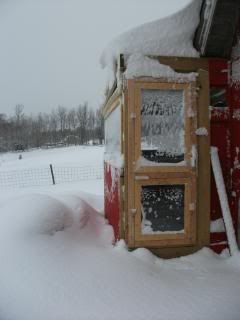
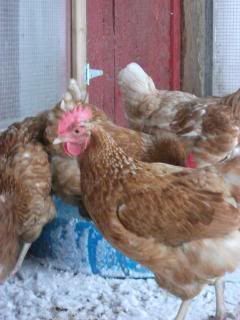
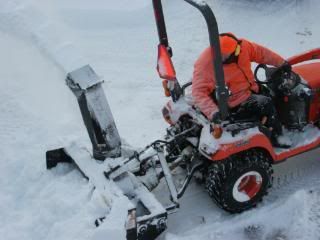
No comments:
Post a Comment